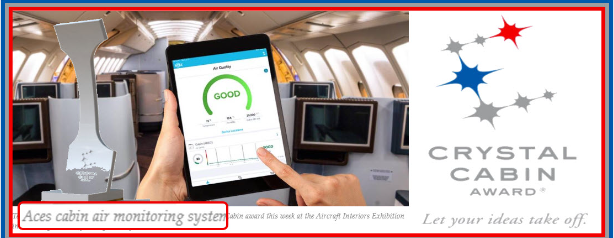The new technology of Teledyne’s ACES may lead to an answer to the contentious Cabin Air Debate

The flight attendants and a number of academicians are ABSOLUTELY convinced that the air bleed off the AIRCRAFT ENGINES CONTAMINATE THE CABIN WITH NOXIOUS FUMES. Their lobbying resulted in several Congressional proposals,one of whichremains in the pending FAA Reauthorization bill. Both EASA and FAA have paraded scientific studies that deny that cabin air quality is a risk to health of all involved. A common thread in this debate has been whether resolution could be possible with scientific tests of inflight conditions.
Below is an excellent AIN article entitled “Teledyne Wins Crystal Cabin Award for Cabin Air Monitoring”. The award (see above image of trophy, left) was created by the Senate of the Free and Hanseatic City of Hamburg and managed by the Crystal Cabin Award Association. This international award for excellence in aircraft interior innovation is intended to motivate innovation around passenger [SAFETY and] comfort.
Teledyne says that its ACES system has already been FAA certificated for use on Airbus and Boeing narrowbodies and has been installed for four carriers in the U.S., UK, and Australia. That fleet might provide a statistically significant sample of samples to resolve this debate. Hopefully this bitter disagreement will be brought to an end. The Nobel Foundation might consider awarding a prize to ACES for defusing this dynamite contre temps.
Technical innovation may well settle this long standing safety issue.
————————————————————————-
Teledyne Wins Crystal Cabin Award for Cabin Air Monitoring
by Aimee Turner
– June 9, 2023, 7:33 AM
U.S. sensor business Teledyne Controls returned home from the Aircraft Interiors Expo in Hamburg, Germany, this week with a prestigious 2023 Crystal Cabin Award for its contributions to health and safety. The company was honored for its Aces cabin environment monitoring system, which ALLOWS AIRCRAFT OPERATORS TO MONITOR, MEASURE, AND ANALYZE AIR QUALITY IN BOTH THE CABIN AND THE FLIGHT DECK, CHECKING FOR POTENTIALLY HARMFUL CONTAMINANTS.
Also, during the show, Teledyne launched an app that it expects will make the Aces system more useful for private aviation customers. The technology has already been FAA certified for use on Airbus and Boeing narrowbodies and has been installed for four carriers in the U.S., UK, and Australia. Teledyne’s head of sales and marketing Steve Quimby said that he expects the system to be installed in a business jet before NBAA-BACE in October.
Aces monitors several parameters in real-time and relays the data directly to ground stations using laboratory-standard sensors to check not only humidity and temperature levels but airborne particulates, carbon dioxide, carbon monoxide, and ozone, as well as volatile organic compounds. As soon as the aircraft is powered up, Aces performs continuous air sensing and monitoring and records data that is stored in the Aces onboard units.
That real-time data can now be viewed through an Aces mobile app that was developed earlier this year. This allows the data recorded in real-time by the Aces onboard devices to be viewed on mobile devices such as iPads, providing passengers with instant access to the air quality index in the aircraft along with snapshots of key monitored parameters.
“From a business aviation standpoint,” he said, “it’s about comfort, it’s about style. Aces offers the passenger the opportunity to be able to see the cabin environment including the temperature, the humidity, and the pressurization. As they’re flying at higher altitudes, this can give passengers traveling in a business jet that comfort of being able to ask the pilot to adapt the conditions in the cabin.”
While the system provides new insights into cabin air quality, the Crystal Cabin jury also lauded Aces’ ability to reduce airline maintenance costs and aircraft downtime by allowing operators to validate repairs onboard with no additional sensor systems required. Aces transmits the data itself without relying on any other aircraft connectivity systems. This transfer happens seamlessly and securely via Aces’ built-in wireless module, which works with both cellular (4G LTE) and Wi-Fi networks when the aircraft is on the ground enabling the operator to identify emerging issues and document maintenance efforts.